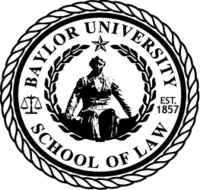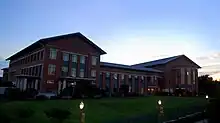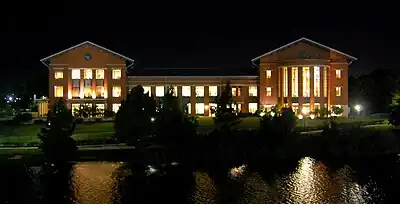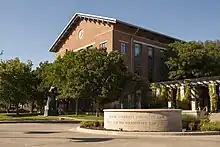Baylor Law School
Baylor Law School is the oldest law school in Texas.[3] Baylor Law School is affiliated with Baylor University and located in Waco, Texas. The school has been accredited by the American Bar Association since 1931 and has been a member of the Association of American Law Schools since 1938.[4] The program offers training in all facets of law, including theoretical analysis, practical application, legal writing, advocacy, professional responsibility, and negotiation and counseling skills.
| Baylor University School of Law | |
|---|---|
 | |
| Parent school | Baylor University |
| Religious affiliation | Baptist General Convention of Texas |
| Established | 1857 (original) 1920 (re-establishment) |
| School type | Private law school |
| Dean | Bradley J.B. Toben |
| Location | Waco, Texas, U.S. |
| Enrollment | 448 (2009)[1] |
| Faculty | 31 full-time (2009)[1] |
| USNWR ranking | 49th (2024)[2] |
| Website | www |
History

Established in 1857, Baylor Law School was the first law school in Texas and the second law school west of the Mississippi River.[5] Law classes continued until 1883 when the school was discontinued. In 1920, the Board of Trustees reestablished the law school (called the Law Department at that time) under the direction of Dean Allen G. Flowers. The school was temporarily suspended from 1943–1946 as a result of World War II.
Bradley J.B. Toben has served as Dean of the Law School since 1991.[6] He is the longest serving dean in the nation among the 200 ABA accredited law schools.[7]
Academics

Admissions
For the classes entering in 2022, Baylor Law School accepted 23.8% of applicants and 17.57% of those accepted enrolled with the average enrollee having a 163 LSAT score and 3.72 undergraduate GPA.[8]
Class structure
The school operates on a quarter system[9] and has four graduating classes per year. Each matriculate class has a separate application pool and applicants are required to apply to the quarter in which they would like to begin.
A typical academic year consists of three quarters, with students choosing to take off the fourth quarter of the year to complete a clerkship or internship; however, students may elect to complete the program in only 27 months by attending every quarter. The school's curriculum focuses more on the positive state of the law than a normative one and on actual practice in the court system.
Degrees
In addition to the standard Juris Doctor degree, Baylor Law students can obtain a combined JD with either the Master of Business Administration (both traditional and with an emphasis in healthcare administration), the Master of Taxation, the Master of Public Policy and Administration, or the Master of Divinity degree.[10]
First-year program
First-year students are required to take the following courses and satisfactory completion is required before moving to upper-level courses. The required courses are:
- Civil Procedure
- Constitutional Law: Structure, Power and Legislation (4)
- Contracts
- Contracts 1
- Contracts 2
- Criminal Law
- Criminal Procedure
- Legal Analysis, Research, and Communication (LARC)
- LARC 1 -- Introduction to Legal Writing
- LARC 2 -- Introduction to Legal Research
- LARC 3 -- Persuasive Communications
- Property
- Property 1
- Property 2
- Torts
- Torts 1
- Torts 2
Upper Class Required Courses
The following courses are mandatory upper-class courses for all student (Practice Court classes are shown separately):
- Business Organizations I
- Constitutional Law: Individual Liberties
- Legal Analysis, Research, and Communication (LARC)
- LARC 4 -- Transactional Drafting
- LARC 5 -- Litigation Drafting
- Professional Responsibility
- Remedies
- Taxation and Accounting Principles for Lawyers
- Trusts and Estates
Practice Court
The hallmark of the law school curriculum is its Practice Court program. Practice Court traces its roots to the original school; it was returned in 1922 shortly after the school was reinstituted. Though practice court is designed primarily for students who will practice law before Texas trial courts, it is mandatory for all students.
The program consists of three courses. Students should plan to be available to participate in course work from 1:00 PM onward each week day (1:20 PM for Practice Court 3) and should expect to work late into the evenings:
- Practice Court 1: Pre-Trial Practice & Procedure
- Practice Court 2: Trial Evidence, Procedure & Practice
- Practice Court 3: Trial and Post-Trial Practice, Procedure & Evidence (this includes the "Big Trial", whereby students are assigned to represent a party; the students must file pleadings, engage in discovery, conduct jury selection, argue their case, and engage in post-trial motion practice to secure their judgment).
A student can, if desired, choose to concentrate in one of fifteen specialized areas of law:
- Administrative Practice
- Business Litigation
- Business Planning
- Commercial Law
- Criminal Practice
- Estate Planning
- Family Law Practice
- Fiduciary Litigation
- General Civil Litigation
- Healthcare Law
- Intellectual Property
- Intellectual Property Litigation
- Personal Injury Litigation
- Public Interest Law
- Real Estate and Natural Resources
Law review
| Language | English |
|---|---|
| Publication details | |
| History | 1948–present |
| Frequency | 3/year |
| Standard abbreviations | |
| Bluebook | Baylor L. Rev. |
| ISO 4 | Bayl. law rev. |
| Indexing | |
| ISSN | 0005-7274 |
| OCLC no. | 818986563 |
| Links | |
The Baylor Law Review is the law school's official student-run law review.[11] The journal was founded in 1948[12] and is published three times per year (Fall, Winter and Spring).[13] Students may grade on to the Law Review at the end of their first year or later as upper-quarters, being selected through a write-on competition, or writing a note or comment for the journal that is selected for publication.[14]
Legal clinics
Students can gain experience by working Baylor Law's legal clinics.[15] Baylor Law currently has five legal clinics: Estate Planning, Immigration, Intellectual Property and Entrepreneurship, Trial Advocacy, and the Veterans Clinic.[16] Over the past few years, more than 1,500 central Texans have been served by Baylor Law students, faculty, and volunteer attorneys.[17]
Baylor Law's Director of Clinical Programs, Josh Borderud, was selected in early 2020 to receive the prestigious Sandra Day O’Connor Award for Professional Service from the American Inns of Court.[18] The Sandra Day O’Connor Award for Professional Service is awarded each year to honor an American Inn of Court member in practice for ten or fewer years for excellence in public interest or pro bono activities.[19]
Employment
According to Baylor's official 2019 ABA-required disclosures, 93.7% of the Class of 2019 obtained full-time, long-term, JD-required employment nine months after graduation.[20] Baylor's Law School Transparency under-employment score is 3.9%, indicating the percentage of the Class of 2019 unemployed, pursuing an additional degree, or working in a non-professional, short-term, or part-time job nine months after graduation.[21]
Costs
The total cost of attendance (indicating the cost of tuition, fees, and living expenses) at Baylor for the 2022-23 academic year is $87,284.[22] The Law School Transparency estimated debt-financed cost of attendance for three years is $310,638.[23]
Rankings
- Baylor Law School ranked No. 58 in U.S. News & World Report's 2023 edition of "America's Best Law Schools."[24]
- In its 2021 law specialties rankings, U.S. News & World Report ranked Baylor Law's Trial Advocacy program as the second best in the nation.[25]
- Above the Law ranked Baylor Law School at No. 33 in 2016.[26]
- Baylor Law is ranked #29 nationally in terms of bar passage rate among first-time test takers (92.1%), and it outperforms by +17.6% the state of Texas's overall bar passage rate of 74.5%.[27]
- Baylor Law ranks #34 in terms of graduates employed ten months after graduation (85.4%) and #77 in terms of graduates employed at the time of graduation (51.5%).[28]
- Baylor Law is tied for #53 in terms of the median starting salary among graduates working in private practice as law firm associates ($85,000).[29]
- Baylor Law is tied for #24 in terms of median starting salary among graduates working in government jobs or judicial clerkships at the federal or state level ($61,105).
Notable alumni

- James B. Adams – Texas legislator, and former acting director of the Federal Bureau of Investigation (15 to 23 February 1978)
- John L Grayson – Texas Litigator and Construction lawyer (JD 1983)
- Phillip Baldwin – Justice, U.S. Court of Appeals for the Federal Circuit[30]
- Charles Wallace Barrow – Former Justice, Texas Supreme Court[31]
- Roy Bass – Waco native and mayor of Lubbock from 1974–1978
- Ed Blizzard – Pharmaceutical injury attorney
- Beau Boulter – U.S. Congressman (1985–1989)[32]
- Bob Bullock – Texas' 38th Lieutenant Governor[33]
- Lee Roy Calderon – Senior Attorney for the University of Texas System
- Tim Curry – District attorney of Tarrant County from 1972 to 2009[34]
- Marion Price Daniel (1932) – United States Senator (1953—1957); Governor of Texas (1957—1963); Speaker of the Texas House of Representatives (1943–1945); Justice, Texas Supreme Court (1971–1978).
- Leonard Davis – Judge, United States District Court for the Eastern District of Texas (2002–2015)[35]
- Jack M. Fields – U.S. Congressman (1981–1997)[36]
- Sidney A. Fitzwater – Judge, U.S. District Court, Northern District of Texas (1986–present)[37]
- James Rodney Gilstrap - Judge, United States District Court for the Eastern District of Texas (2011–present)
- Louie Gohmert – U.S. Congressman (2005–present)[38]
- Sam Blakely Hall Jr. – U.S. Congressman (1975–1985) and U.S. District Judge, Eastern District of Texas[39]
- John Lee Hancock – Screenplay writer and director of The Rookie, The Alamo, and The Blind Side.[40]
- Andrew S. Hanen – Judge, U.S. District Court, Southern District of Texas (2002–present)[41]
- VADM John G. Hannink - 44th Judge Advocate General of the Navy[42]
- Robert Heard – Reporter and journalist for the Associated Press[43]
- Jack English Hightower (1951) – U.S. House of Representatives, (1975–1985)[44]
- Ashley C. Hoff - U.S. Attorney for the Western District of Texas (2021–2022)
- Bryan Hughes (1995) – Republican member of the Texas Senate from District 1[45]
- COL Leon Jaworski (1924) – Watergate Special Prosecutor; Senior Partner, Fulbright & Jaworski Houston, Texas; Served on the Warren Commission; President, American Bar Association (1971–1972); Chief of War Crimes detachment of the JAG Corps of the US Army (1944–1946); Treasurer and co-founder, Democrats for Reagan.
- James E. Kinkeade – Judge, United States District Court for the Northern District of Texas (2002–Present)[46]
- Tim Kleinschmidt, J.D. (1981) - Member of the Texas House of Representatives from Giddings; city attorney in Giddings and Lexington[47]
- Tryon D. Lewis, J.D. – Member of the Texas House of Representatives from Odessa; former 161st State Judicial District judge[48]
- Thomas C. Mann- U.S. Ambassador to El Salvador (1955–1957) and US Ambassador to Mexico (1961–1963)
- K. Nicole Mitchell, J.D. (2006) – U.S. Magistrate Judge, U.S. District Court for the Eastern District of Texas (2013–present)
- Amos L. Mazzant III (J.D. 1990) – Judge, United States District Court for the Eastern District of Texas (2014-present)[49]
- Priscilla Owen, J.D. (1977) – Judge, U.S. Fifth Circuit Court of Appeals (2005 – present); Former Texas Supreme Court Justice (1994–2005).[50]
- William Robert (Bob) Poage (1924) – U.S. House of Representatives, (1937–1978)[51]
- Graham B. Purcell, Jr., LL.B (1949) – U.S. representative from Texas' 13th congressional district from 1962 to 1973[52]
- Kevin Reynolds – Former Texas lawyer and director of Fandango, Robin Hood: Prince of Thieves, and Waterworld.
- Max Sandlin – Judge, U.S. Congressman (1997–2005)[53]
- William Sessions – Director of the FBI (1987–1993)[54]
- Justice Rebecca Simmons- Justice, Fourth Court of Appeals, Texas[55]
- Byron Tunnell – Former Speaker of the Texas House of Representatives[56]
- T. John Ward – Judge, United States District Court for the Eastern District of Texas(1999–present)
- Kirk Watson – Mayor of Austin and former state senator[57]
- Mark Wells White – Governor of Texas (1983–1987)
- John Eddie Williams – Counsel, Texas Tobacco Settlement (Baylor University's football field is named John Eddie Williams Field in recognition of Williams' donation to the program)[58]
- Frank Wilson – U.S. Congressman (1947–1955)[59]
References
- "Baylor University School of Law, ABA Law School Data" (PDF). LSAC. Archived from the original (PDF) on 10 July 2009. Retrieved 12 August 2009.
- "Baylor University". Retrieved 31 March 2022.
- "Texas Accredited Law Schools – Law Schools". lawschool.uslegal.com. US Legal Inc. Retrieved 25 September 2020.
- "Accreditation". Law | Baylor University. Retrieved 25 September 2020.
- "About". Law | Baylor University. Retrieved 25 September 2020.
- "Brad Toben". Law School Faculty and Staff | Baylor University. Retrieved 25 September 2020.
- "Brad Toben". Law School Faculty and Staff | Baylor University. Retrieved 25 September 2020.
- "Baylor University - 2022 Standard 509 Information Report". abarequireddisclosures.org. American Bar Association. Retrieved 10 March 2023.
- "Quarter System". Law | Baylor University. Retrieved 25 September 2020.
- "Quick Facts". Law | Baylor University. Retrieved 25 September 2020.
- "About Baylor Law Review". Baylor University Law School Review.
- "Baylor Law Review". HeinOnline.
- "Subscriptions". Baylor University Law Review.
- "Join Baylor Law Review". Baylor University Law Review.
- "Legal Clinics". Law | Baylor University. Retrieved 25 September 2020.
- "Legal Clinics". Law | Baylor University. Retrieved 25 September 2020.
- "Legal Clinics". Law | Baylor University. Retrieved 25 September 2020.
- "News". Law | Baylor University. Retrieved 25 September 2020.
- "News". Law | Baylor University. Retrieved 25 September 2020.
- "Baylor Law School Class of 2019 Summary Report" (PDF).
- "Baylor University". www.lstreports.com. Retrieved 25 September 2020.
- "Estimated Costs". Law | Baylor University. Retrieved 29 October 2022.
- "Baylor University, Finances". www.lstreports.com. Retrieved 25 September 2020.
- "Baylor Law School Overview". U.S. News.
- "Best Trial Advocacy Programs". U.S. News.
- "The 2016 ATL Top 50 Law School Rankings". Above the Law. Retrieved 25 September 2020.
- "Baylor University - 2020 Law School Profile". www.ilrg.com. Retrieved 25 September 2020.
- "Baylor University - 2020 Law School Profile". www.ilrg.com. Retrieved 25 September 2020.
- "Baylor University - 2020 Law School Profile". www.ilrg.com. Retrieved 25 September 2020.
- "Phillip Benjamin Baldwin". Federal Judicial Center. Retrieved 1 January 2013.
- "Charles Barrow". Baylor University Waco, Texas. 27 June 2006. Retrieved 1 January 2013.
- "Beau Boulter". Biographical Directory of the United States Congress. Retrieved 1 January 2013.
- "Bob Bullock". Texas State Historical Association. Retrieved 1 January 2013.
- "Tim Curry". Justia. Retrieved 1 January 2013.
- "Leonard Davis". Federal Judicial Center. Retrieved 1 January 2013.
- "Jack Fields". Biographical Directory of the United States Congress. Retrieved 1 January 2013.
- "Sidney A. Fitzwater". Federal Judicial Center. Retrieved 1 January 2013.
- "Louie Gohmert". Biographical Directory of the United States Congress. Retrieved 1 January 2013.
- "Sam B. Hall". Biographical Directory of the United States Congress. Retrieved 1 January 2013.
- "'The Blind Side' Director John Lee Hancock to Speak at Baylor Law Commencement May 1". Baylor University. 29 April 2010. Retrieved 4 November 2021.
- "Andrew S. Hanen". Federal Judicial Center. Retrieved 1 January 2013.
- "Vice Admiral John G. Hannink". United States Navy. Retrieved 21 December 2018.
- Vertuno, Jim (23 April 2014). "Former AP reporter Robert Heard dies at age 84". Associated Press. Archived from the original on 14 May 2014. Retrieved 12 May 2014.
- "Jack English Hightower". Biographical Directory of the United States Congress. Retrieved 1 January 2013.
- "Bryan Hughes". Retrieved 30 November 2022.
- "James Ed Kinkeade". Retrieved 1 October 2018.
- "Rep. Kleinschmidt, Tim (District 17)". house.texas.gov. Retrieved 25 February 2014.
- "Tryon D. Lewis". Texas House of Representatives. Retrieved 1 January 2013.
- "District Judge Amos L. Mazzant, III | Eastern District of Texas | United States District Court".
- "Priscilla Owen". Biographical Directory of the United States Congress. Retrieved 1 January 2013.
- "William R. Poage". Biographical Directory of the United States Congress. Retrieved 1 January 2013.
- "Purcell, Graham Boynton, Jr". bioguide.congress.gov. Retrieved 27 February 2013.
- "Max Sandlin". Biographical Directory of the United States Congress. Retrieved 1 January 2013.
- "Baylor Law Mourns the Passing of Former FBI Director William S. Sessions, LL.B. '56". Baylor University. Baylor University. Retrieved 12 November 2021.
- "Simmons to fill vacancy on 408th District Court". bizjournals.com. San Antonio Business Journal. 7 April 2003. Retrieved 12 November 2021.
- "Byron M. Tunnell". Texas Politics. Archived from the original on 12 May 2014. Retrieved 1 January 2013.
- "Kirk Watson". Project Vote Smart. Retrieved 1 January 2013.
- "John Eddie Williams Makes Significant Gift to New Baylor Football Stadium". Baylor Media Communications. 9 May 2012.
- "WILSON, Joseph Franklin - Biographical Information". bioguide.congress.gov. Retrieved 8 June 2015.